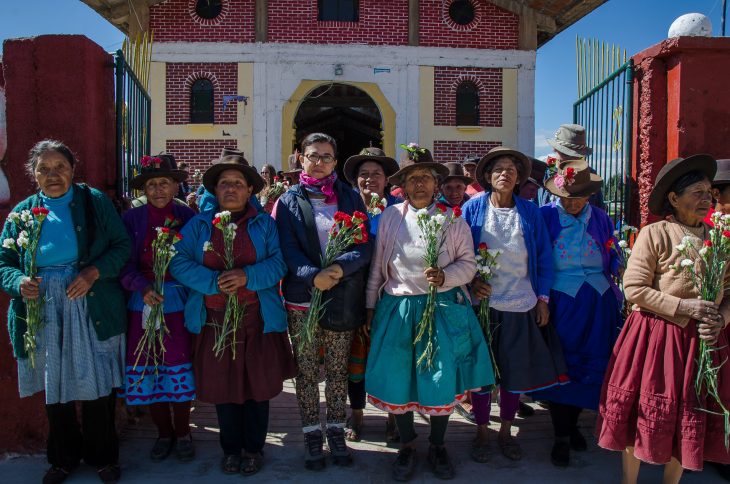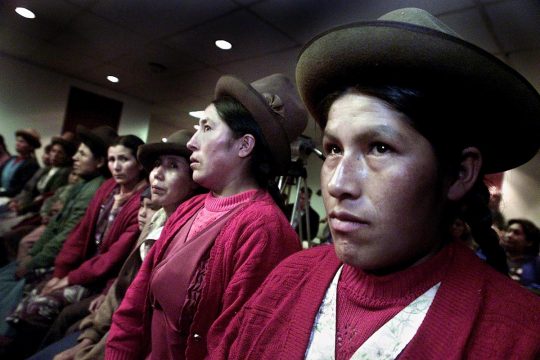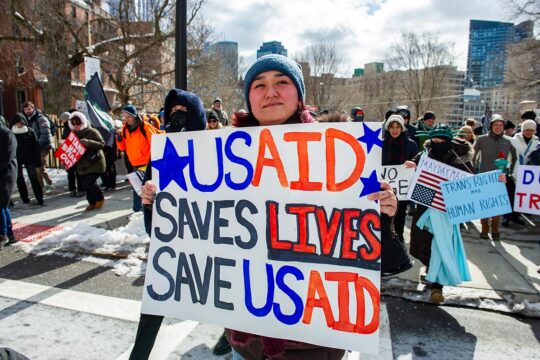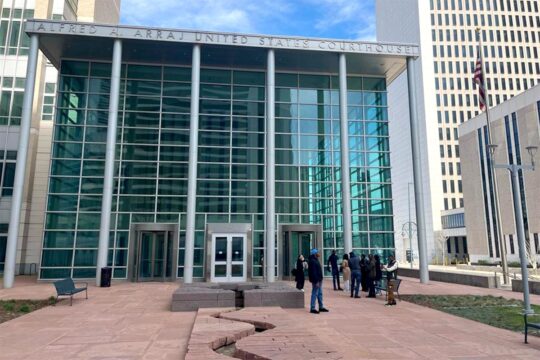The majestic yet forbidding landscape of the Peruvian highlands hides grim secrets. The country’s Ayacucho region was the cradle of Maoist guerrilla group Shining Path, which waged a total and ultimately futile war against the Peruvian state between 1980 and 2000. Many of the forgotten victims of the 20-year internal armed conflict lie buried or simply abandoned in Ayacucho’s mountain passes, old mineshafts, and makeshift hillside cemeteries.
Thousands of peasant farmers and highland townsfolk were slaughtered in the internecine warfare, with state and guerrilla forces vying to outdo one another in the use of exemplary terror to compel loyalty or at least obedience from local communities. Today, abandoned military bases dot the landscape, hastily-scrawled Senderista symbols are still visible on clifftops, and local people talk in hushed tones about the day the ‘terrucos’ (terrorists), or the army, came to town. Victims’ sons, daughters and, particularly, widows continue to suffer substantial privations in a still-patriarchal Andean social structure where manual labour and a male head of household are almost essential to daily life.
At a recent commemoration in the highland town of Hualla, a colourful procession of relatives made its way to the town cemetery, after a Catholic mass for victims was celebrated in the main square. Impromptu speeches in Quechua and Spanish recalled dozens of deaths and disappearances amongst the townsfolk. Women told how they would run after the army trucks that took away their sons and husbands, or walk for hours to the nearby military base, keeping vigil in vain, or handing over money, food and sexual favours demanded by soldiers as bribes for possibly sparing the life of a detainee. Speeches and testimonies at the cemetery made repeated reference to the perceived insufficiency of the state economic reparations programme, which assigns 10,000 Peruvian soles (approximately USD 3,000) to be shared among the sometimes numerous dependants of a victim of fatal violence. But when the group scattered to tend the graves of their loved ones, another, equally strongly felt, need became apparent: many relatives have nowhere to mourn, and no remains to bury or honour. One woman spoke movingly of her desire to give her father a dignified resting place: “It’s a thing of pride to have a father… I would like to have mine, even though I know he’s dead…”.[1]
Her wish may have just come one small step closer to being granted. In late June 2016, outgoing Peruvian president Ollanta Humala signed into law the Ley de Búsqueda de Personas Desaparecidas (‘Law on the Search for Disappeared Persons’). The law mandates the country’s Justice Ministry to set up a national plan for the search and identification of persons disappeared during the 1980-2000 armed conflict, including the creation of a DNA database to store reference samples donated by victims’ relatives. The law adopts an explicitly humanitarian focus, defined in the text’s Article 2 as a search process specifically oriented to the location and restitution of remains (rather than investigation of the criminal responsibilities of perpetrators). The law’s supporters are nonetheless quick to point out that the new system is designed to operate in parallel to, rather than instead of, existing criminal justice initiatives.
The non-state Peruvian Forensic Anthropology Team, EPAF, is the only organisation currently undertaking sustained grassroots work in the highland Ayacucho communities where the majority of the country’s unresolved disappearances took place. EPAF undertakes exhumations and identification, but also strongly emphasises psychosocial accompaniment and presence in the remote towns and villages that state initiatives and authorities rarely reach. In that capacity, EPAF took part alongside other domestic NGOs in the civil society-led process that culminated in the production and adoption of the recent law. [2] In a recent interview (30 June, Sacsamarca, Perú), EPAF operations manager Gisela Ortíz shared the organisation’s views about the issue of disappearances and the potential importance of the new statute:
Q What is the magnitude and current status of the issue of disappeared persons in Peru?
The Peruvian Truth and Reconciliation Commission spoke in 2003 of an overall projected total of over 69,000 fatal or disappeared victims of political violence between 1980 and 2000. Since then, various registers have tried to individualise, with exact names, the numbers and identity of still-disappeared victims within that total. The state currently operates with a figure of 15,731, established by the state forensic service in 2013. EPAF, attempting to create its own register in association with the International Red Cross, arrived in 2008 at an interim figure of 13,721. The fact is that since the state register is not made public, we can’t cross reference to produce an ongoing running total. One of the first jobs of the new state office will be precisely that – to centralise and systematise existing information, about victims and about possible burial sites or mass graves. They also need to expedite the identification of the remains that are already in the hands of state authorities, paying out for DNA testing if necessary. The state also claims to have exhumed the remains of almost 3,000 people between 2006 and July 2014, and to have identified just over half of that total. But many of those exhumations were done mainly to ratify the identity or cause of death of people whose relatives already knew or strongly suspected where they were. The remaining cases could be much more challenging. Also, because remains at present can only be exhumed as part of ongoing criminal investigations, some have been identified but still haven’t been handed back to their relatives. Or, even though the prosecutor releases the remains, relatives can’t even afford to claim them, because the bodies have been taken from local communities to prosecutors’ offices or laboratories in the cities. Relatives have to pay their own way to claim the remains back, and many simply can’t afford the travel, transport and burial costs or to leave their crops and herds unattended for days at a time. But people know, they’ve heard, that meanwhile their loved ones’ remains are stacked up in cardboard boxes in some government office and that causes them real distress.
Q Will the new law help to overcome these problems?
Well, it creates a separate entity whose priority is to find remains, hand them back, and help relatives to bury them in a dignified and appropriate way. Under the old system, if someone wanted their relative found, their only option was to lodge a formal criminal complaint with the public prosecutor. People are often reluctant to do that, for any number of reasons. In small communities, where the violence set neighbour against neighbour or town against town, people are nervous of being seen to take action against known perpetrators who still live nearby. But with the new office, the office can be asked to look for the remains and if there is any criminal investigation, it will be set in motion ex officio between the office and the prosecutor. The relatives don’t have to appear as formally involved in starting the case, nor is it their responsibility, as often it was before, to provide all the information, track down witnesses… basically, investigate their own case. Now it’s the state that has to, first, look for their loved one and then, maybe, also investigate, on its own initiative.
Q What will be needed if a law like this one is to be effective in practice? We’ve already seen, for example, that the reparations laws may look OK on paper but are rarely fully delivered here in the rural areas where they’re needed most…
Well, the person named to be in charge of this new office will be important. It’s not so much a matter of what profession or formal background they come from, as of how they approach the role and the sensitivity with which they deal with relatives, on the one hand, and potential tensions or ‘turf wars’ with the public prosecutor’s office, on the other. The public prosecution service was involved in the design of the law, so all of those boundaries between the work of the two entities have been discussed and can be negotiated, but political will and diplomacy will be at a premium. It’s also going to be really important to decentralise. This kind of work can’t be done just from an office in Lima nor even from regional capitals. You need to understand the communities, how they view things… work through local authorities and health centres, if necessary.
Q This law was signed by an outgoing president, Ollanta Humala. Will the new administration, headed by president Pedro Pablo Kuzcksynki, take its responsibilities seriously?
The civil society roundtable that worked for three or four years to lobby for the law, and even prepared a suggested draft text, met with the now president when he was still a candidate and got his written assurance that he would support the implementation of the law, and other measures for victims. So we are hopeful that if we keep monitoring and pressing for progress, we will see some action. The next few months will be crucial, in the lead-up to the new administration’s first national budget in October, where we need to see resources being assigned to make the new office a viable reality and not just something on paper or for outside consumption.
Q Is this an impunity law? Does it trade justice for information about the disappeared?
No. No incentives or immunity will be offered for information leading to the location of previously undiscovered remains, and any exhumation work carried out as a result of the work of the new office will be done in the presence of a public prosecutor, ensuring it can be used as evidence in any future criminal proceeding. The existing criminal justice process won’t be affected or derailed in any way, though it has to be said, that process has hardly been effective or committed in producing justice for victims. The majority of cases have dragged on for ten years or more, and most recent resolutions have shelved cases, absolved people, or come too late as perpetrators have died or fled the country. The new office might even help to reinvigorate formal justice, by finding irrefutable evidence of homicides that triggers a state duty to investigate.
[1] The author was present at the commemoration, and at numerous similar events, meetings and interviews during a three week field study visit to Ayacucho communities with the Peruvian Forensic Anthropology Team EPAF between 15 June and 4 July 2016.
[2] EPAF is part of a national roundtable coordination group that meets regularly about the issue of enforced disappearance. The group is mainly composed of civil society organisations, including the relatives’ association in which Ms Ortíz also participates. The group’s state or state-affiliated membership includes the Human Rights Ombudsman’s office, which was responsible for presenting the text of the new law to Congress on 2 May 2016, in the form of draft bill (‘Proyecto Ley’) no. 5290-2015.






